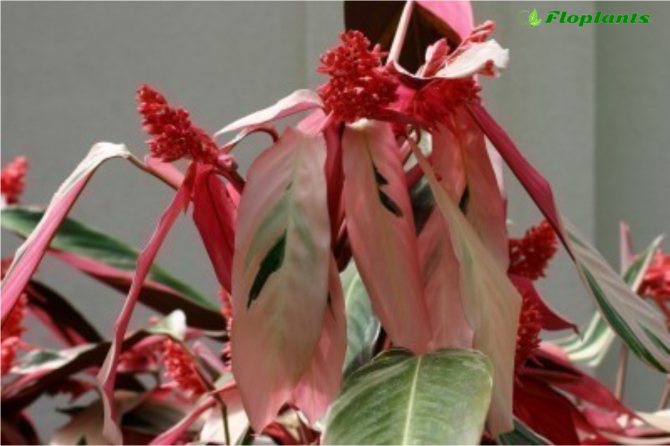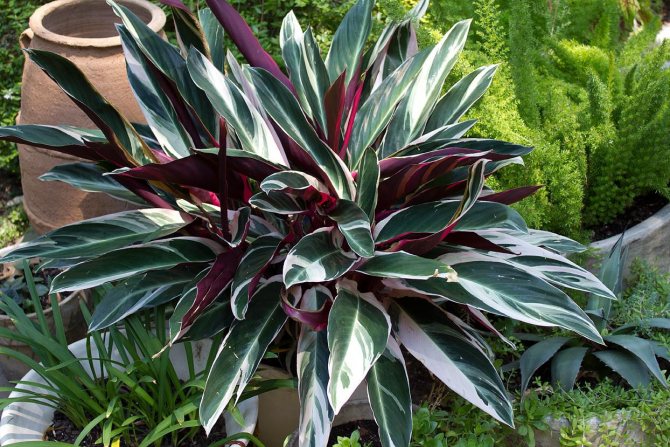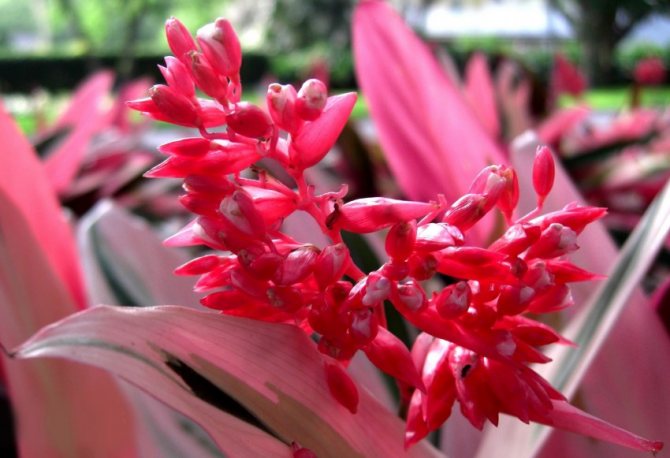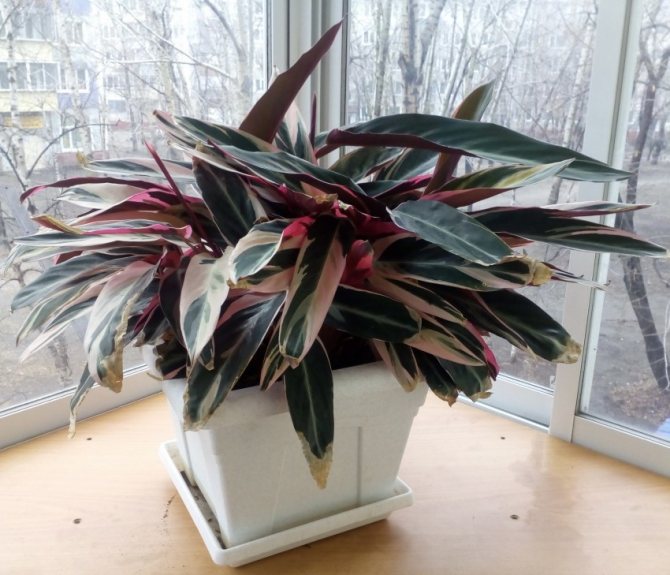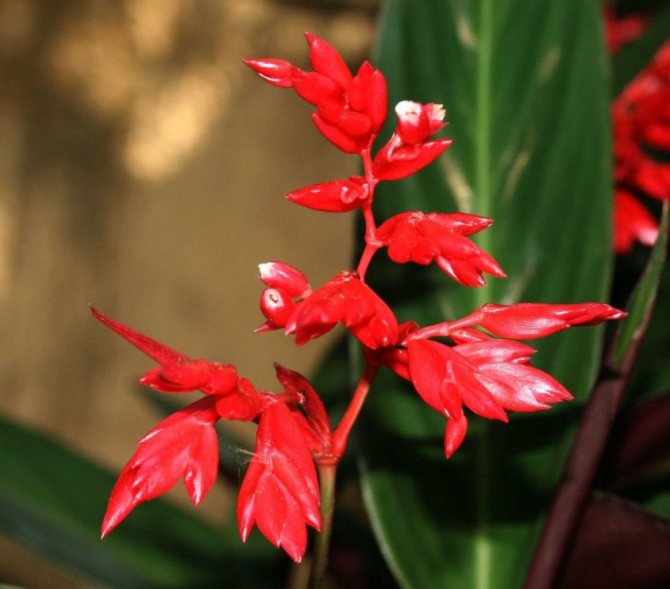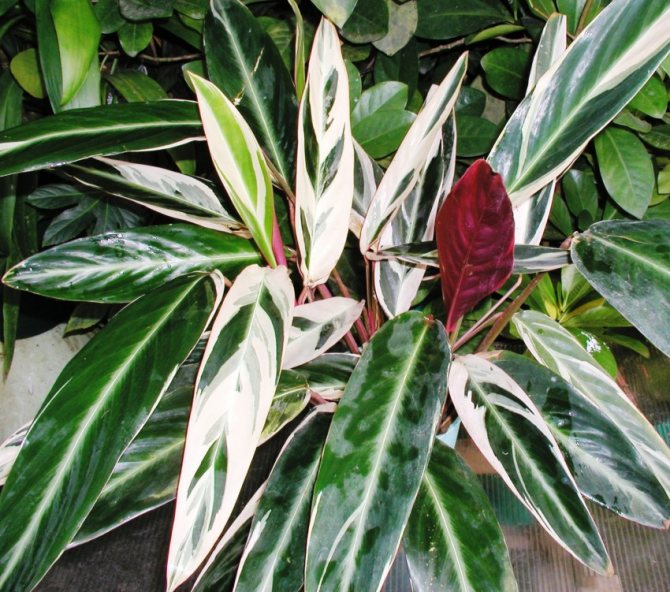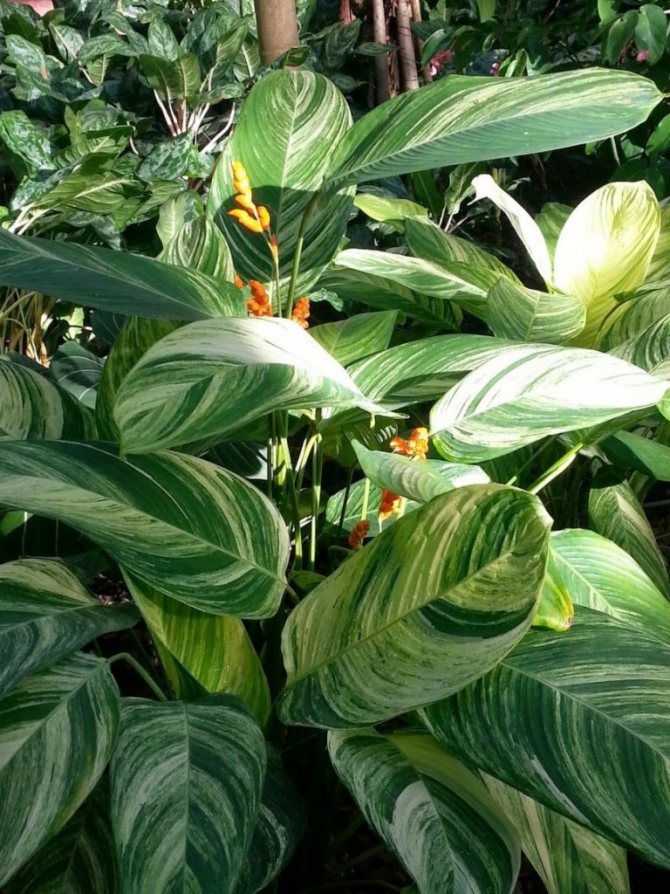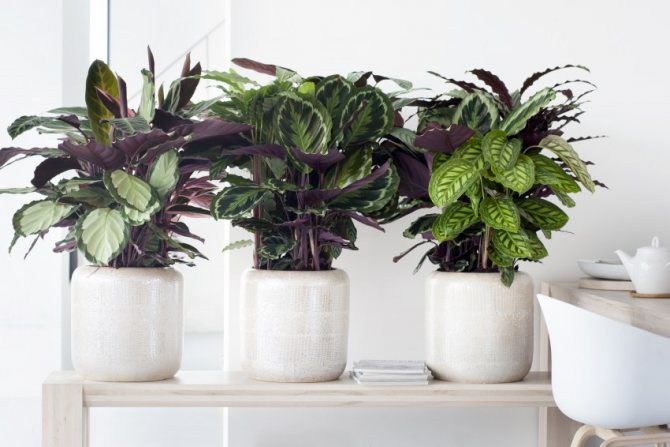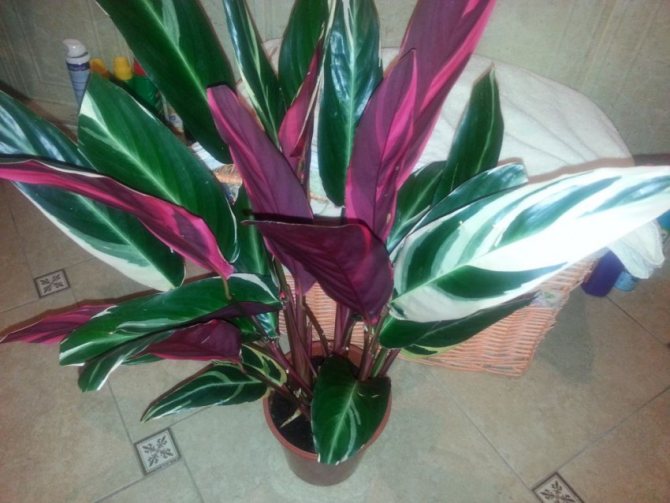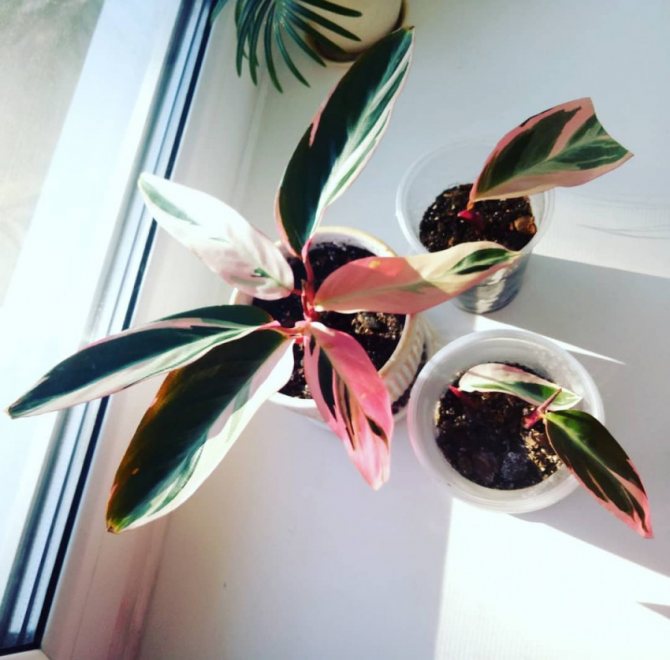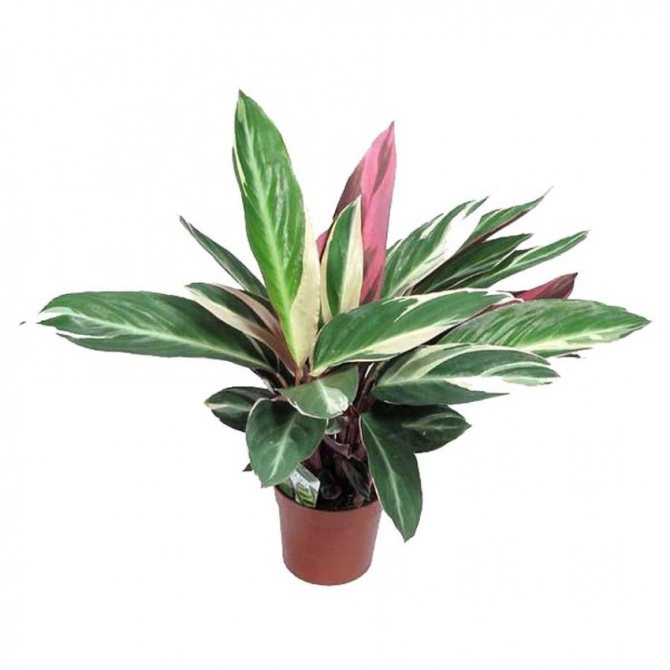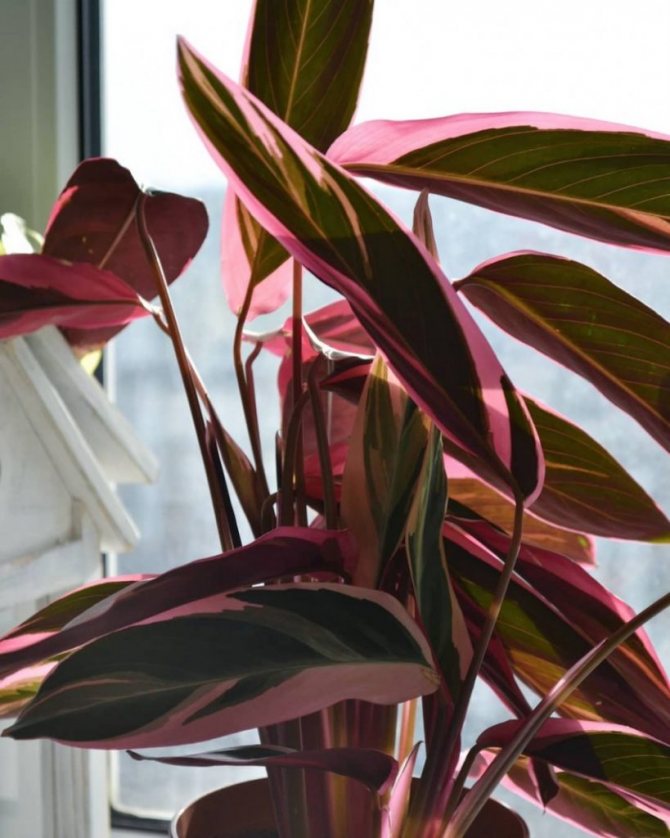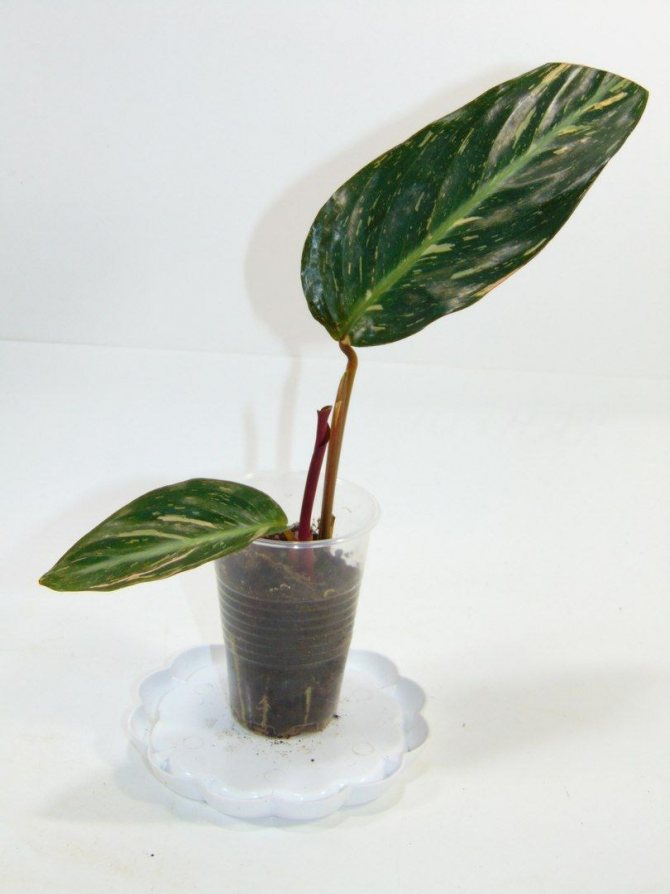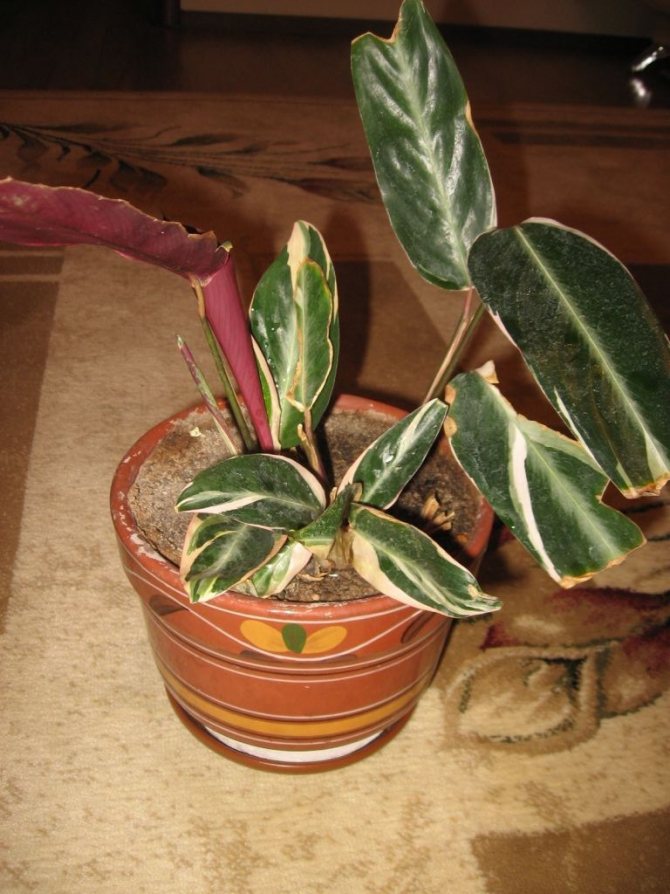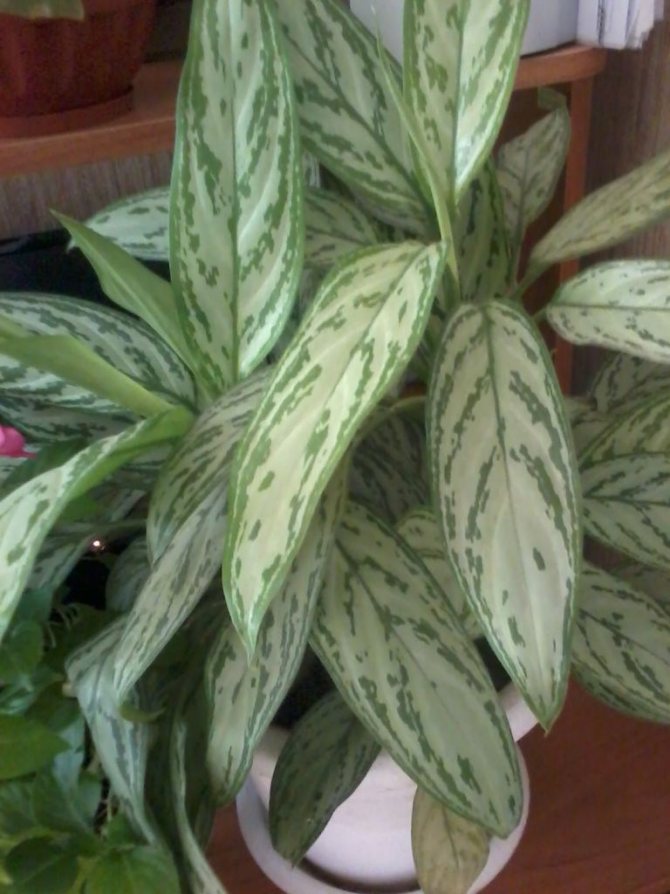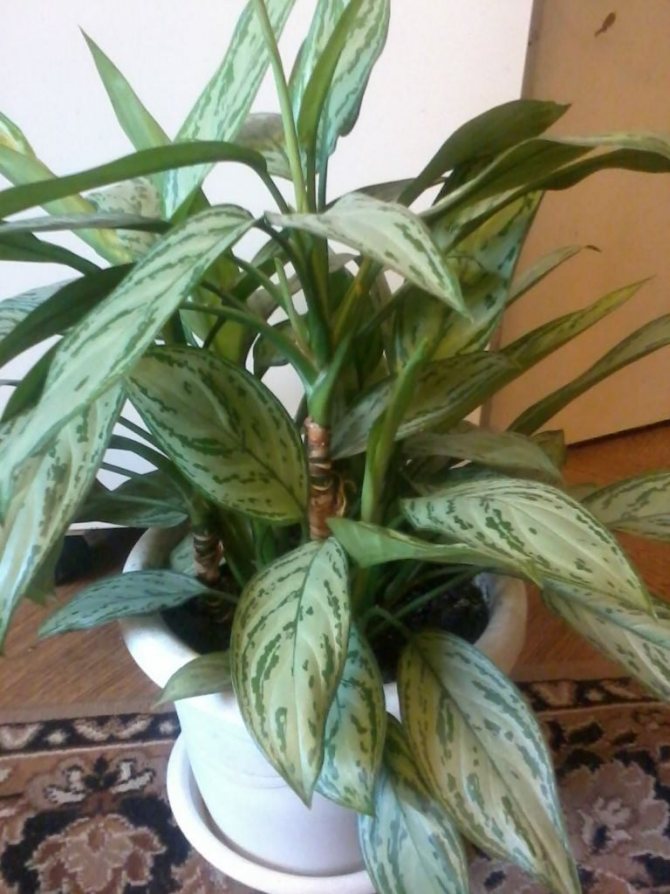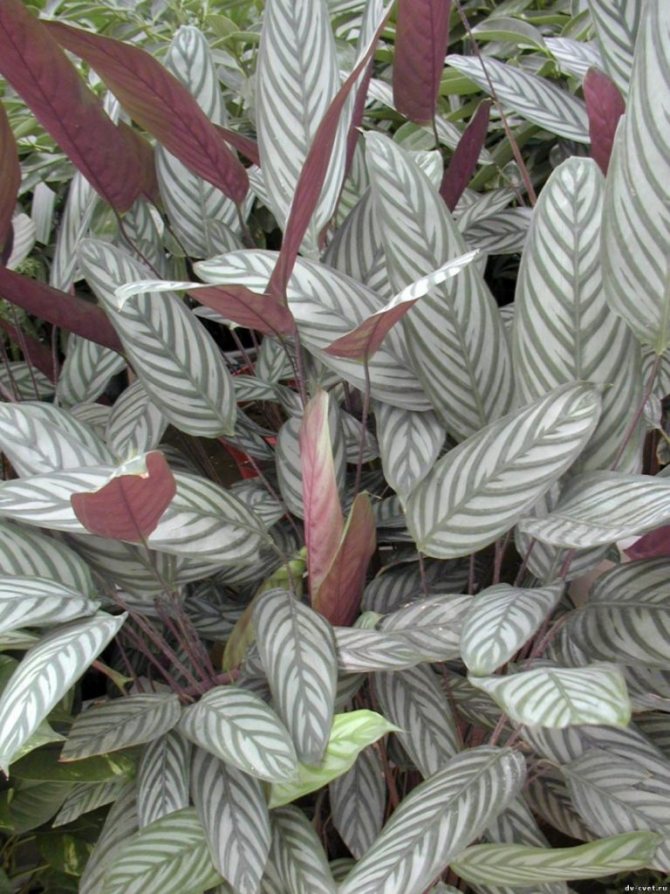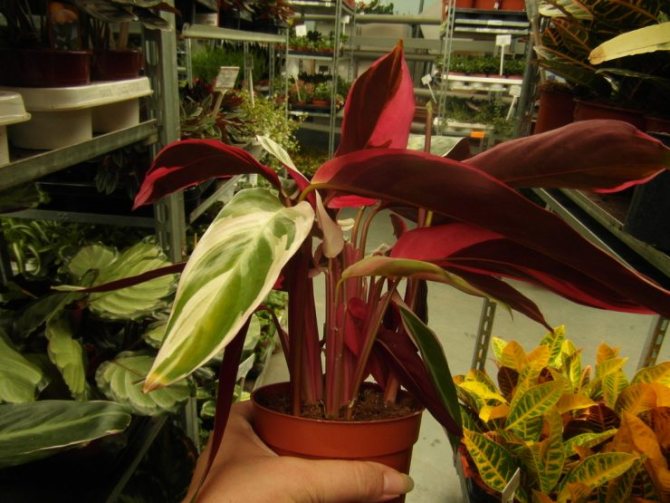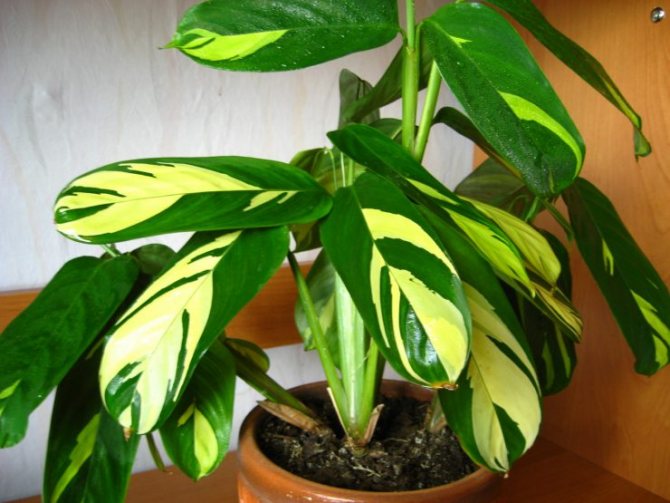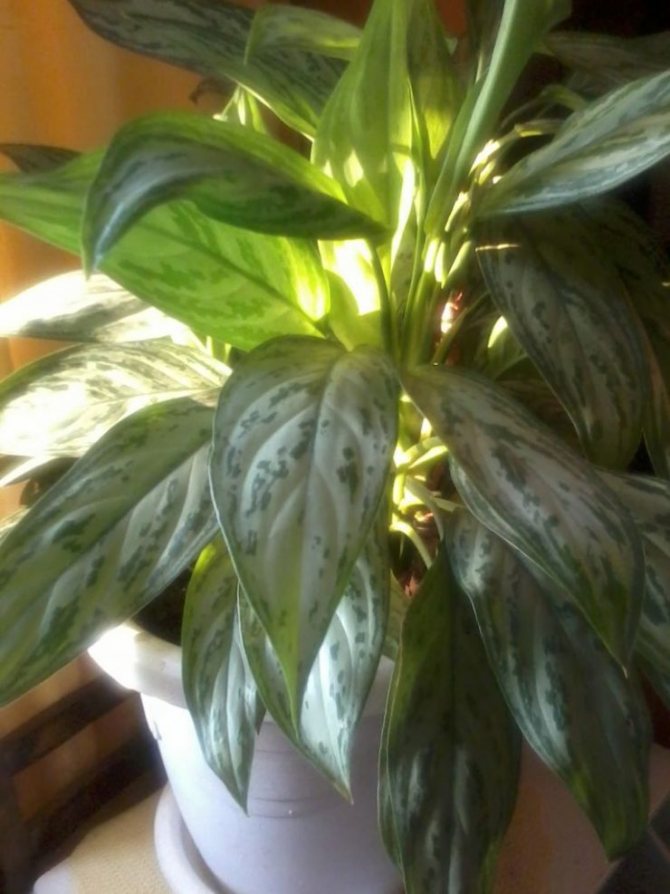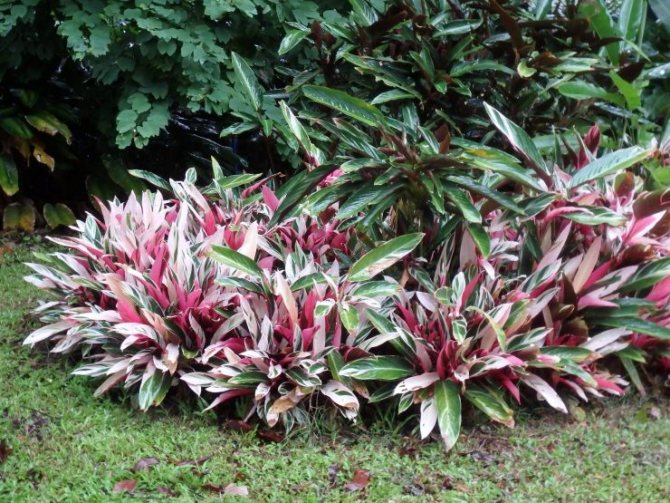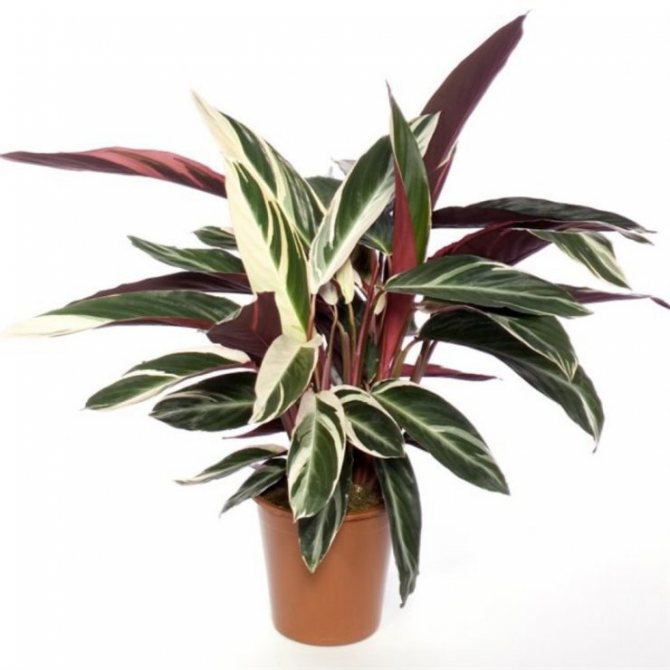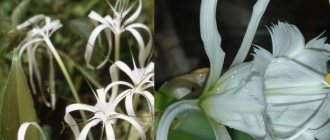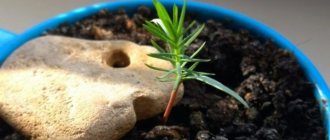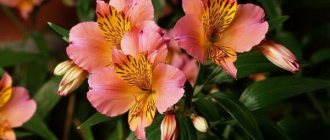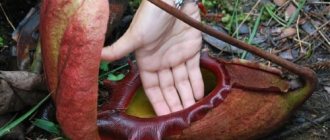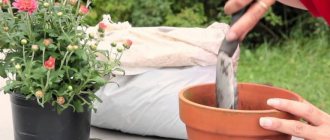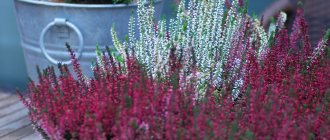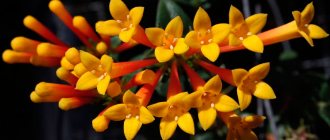The genus Stromanthe contains about 15 species of spectacular herbaceous perennials belonging to the Maranth family. In nature, they all grow in the dense rainy forests of South and Central America, often along the banks of water bodies, in warmth and dampness.
In appearance, this genus of tropical plants can be easily confused with a related ktenant or calathea, and the care for them is completely the same.
Representatives of this type of plants are characterized by one unusual feature - due to the amazing natural mechanism of orientation, the leaf plate always changes its position in relation to the sun during the day, and when there is a lack of moisture, it folds to reduce evaporation.
In the morning, the leaves are oriented to the east to "catch" more early light, but by noon they are more vertical to reduce intense exposure to sunlight.
At night, all representatives of the Marantov family, including Stromanty, have foliage that rises and folds, so that only the inner side of the leaf is visible, so in many countries they are called "prayer plants".
Indoors, culture rarely blooms. In its natural habitat, it forms dense panicles of small nondescript white flowers surrounded by bright orange-red tubular bracts.
The origin and appearance of the plant
One of the most striking examples of the Marantov family is the stromant. The closest relatives of this decorative deciduous perennial include ktenant, arrowroot and calathea.

Stromanta is a representative of the Marantov family
The plant is native to the rainforests of South and Central America. Stromanta likes to hide under the cover of impenetrable thickets of trees, it is found along rivers, in flooded and swampy areas.
In the wild, the stromant grows up to 1.5 m, and at home - 2 times less, only 70 or 80 cm Leaves, large and elongated, are the main decoration of the plant. They resemble the plumage of a bird of paradise. Cream, white, yellow, pink stripes are painted on a green background with generous strokes. The reverse side of the leaf is purple-violet.
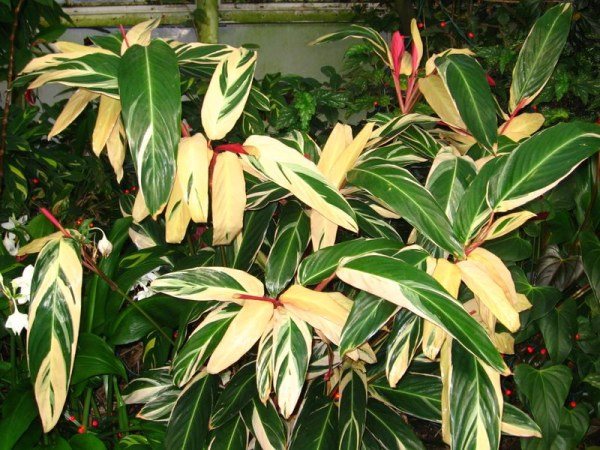

The leaves of the stromant are very decorative
In nature, stromant blooms in the summer season. The inflorescence looks like a panicle. Long peduncles are decorated with bracts of red shades. The flowers themselves are inconspicuous, white. Flowering very often leads to a loss of decorativeness of the plant, it slows down growth, the bush falls apart and does not recover well. It is almost impossible to achieve flowering at home.
The biological feature of the stromant, due to the petiole structure of the leaf plate, is the ability of its leaves to unfold to bright light. In the morning and in the afternoon, they open and go down. And in the evening, in the absence of light, they go up, curled up into a tube. Because of this characteristic of arrowroots, the plant is often called "praying plants".
Stromanta is not only a beautiful plant, but also useful. It activates a person's energy, increasing self-confidence. The plant will help people suffering from insomnia. In the evening, the stromant will help to relax, relieve nervous tension and fatigue.
Caring for a stromant in a room environment is not entirely simple. The plant is capricious and demanding, but if you find an approach to it, then all efforts will pay off handsomely. The stromant will feel best in florariums, terrariums, greenhouses, greenhouses and conservatories.
Stromantu is very often mistakenly called calathea. This is due to the biological proximity of the species and the similarity of the leaf blades. Many scientists studying flora have not even singled out the stromanthus as a separate genus. In flower shops, the plant is often sold as calathea.
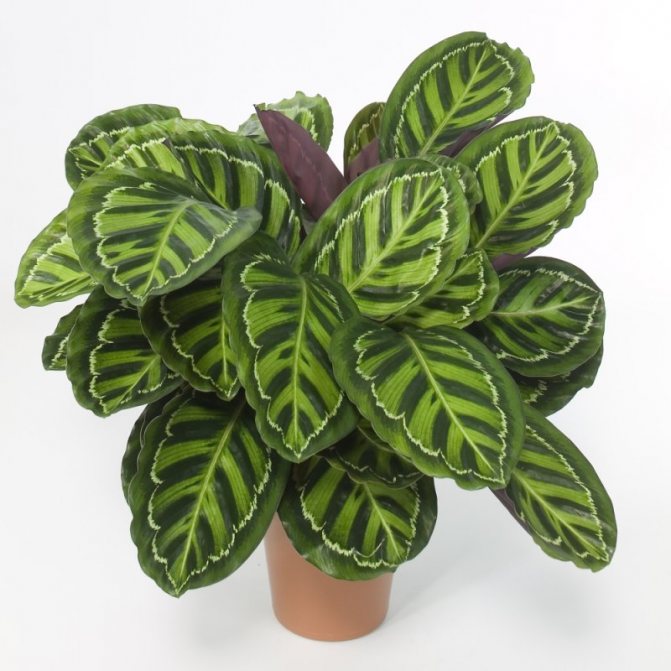

Due to the biological proximity of species, stromanthus is often confused with calathea.
Types and varieties of stromant - table
According to various sources, there are from 5 to 15 types of stromant in nature. But in indoor cultivation, no more than two are cultivated. In addition, many hybrid varieties have been bred.
| Views | Description |
| Stromanta blood red | Leaves are elongated, up to 40 cm long, oval and pointed. The seamy side of the sheet is red. The upper one is more decorative: a pattern similar to the letter V is visible on the light green glossy field. The inflorescence is an ear. The flowers are inconspicuous. |
| Stromanta is pleasant | A small plant only 30 cm high. The leaves, located on long petioles, reach a length of 10–20 cm, a width of 4–5 cm. The leaf plate is oval. It is dyed light green with a dark green herringbone-like pattern. The reverse side of the leaf is silvery green. The flowers are expressionless. |
The most common varieties of blood red stromant - table
| Varieties | Description |
| Stromanta Tricolor or Triostar | The most popular variety for growing at home. The dark green leaf is painted with stripes and spots of olive, beige, light green, white and pink colors. The underside is dark burgundy. |
| Stromanta Multicolor | Smears of white and light green on a dark green background - this is how the upper part of the earnest plate looks unusual. The seamy side of the burgundy red color scheme. |
| Stromantha Maroon | As with all stromants, the lower part of the leaf is pigmented in burgundy tones. The leaf is glossy, dyed green, the central vein is light green. |
| Stromanta Horticolor | Light yellow and light green stripes and streaks adorn the surface of the leaf. Its lower part is dark red in color. |
| Stromanta Stripe Star | The main background of the leaf plate is bright green. The central vein is marked with a light stripe. The lower part of the leaf is red. |
Stromanta Multicolor, Marun, Tricolor and other types of plants in the photo
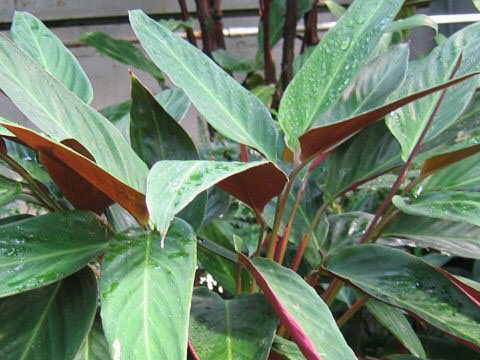

The leaves of the blood-red stromant are elongated, up to 40 cm long
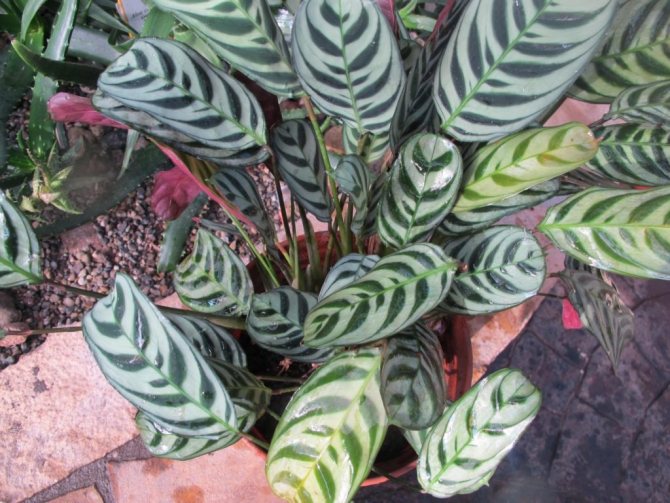

The reverse side of the leaf of the stromant has a pleasant silvery-green color
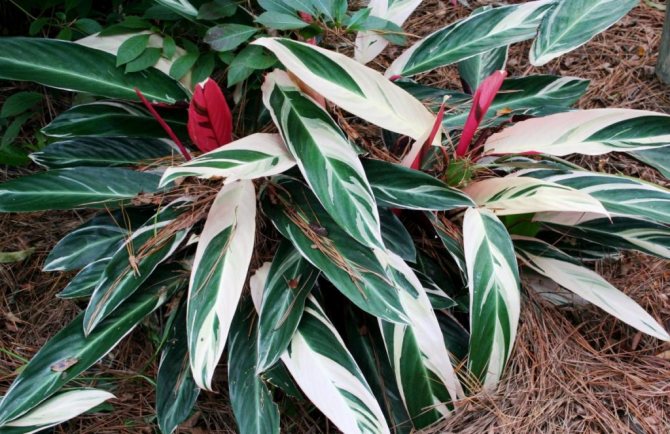

Stromanta Tricolor is the most popular variety for growing at home
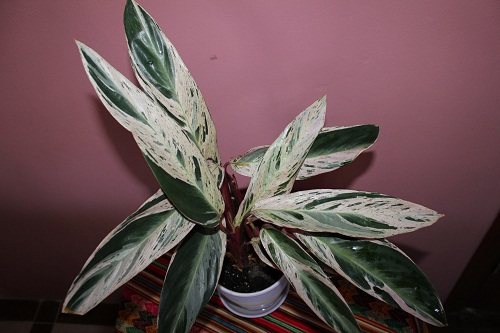

Smears of white and light green color on a dark green background - this is how the upper part of the leaf plate of the Multicolor stromant looks unusual
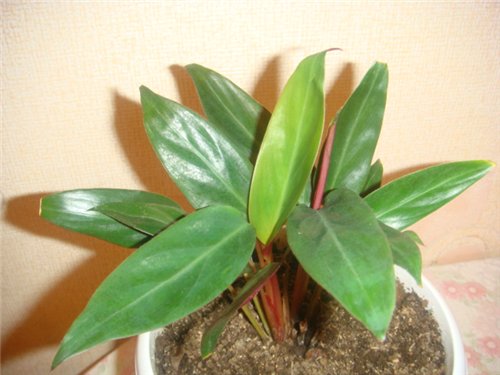

the lower part of the leaf of the Maroon stromant is pigmented with burgundy tones
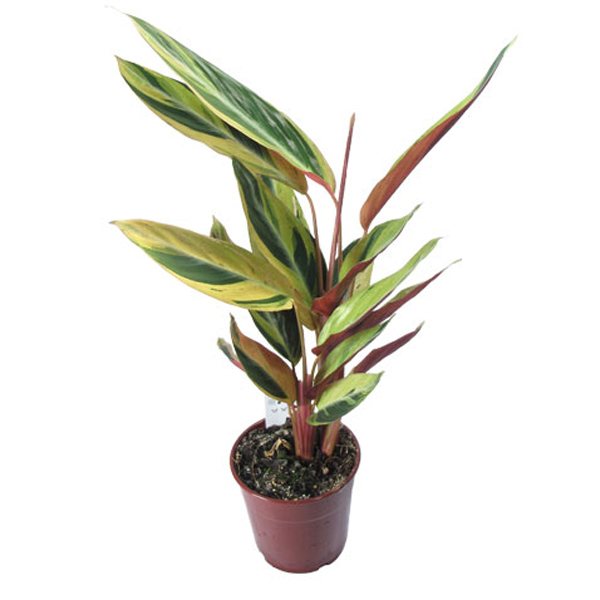

Light yellow and light green stripes and streaks adorn the surface of the Khorticolor stromant leaf


The main background of the leaf plate of the Stripe Star stromant is bright green, and the central vein is marked with a light stripe.
Using top dressing
During the vegetative period, Stromant needs feeding.
But be careful! An increased dosage can kill a tropical flower. It is better to dilute the fertilizer in half and feed it approximately once every 14 days.
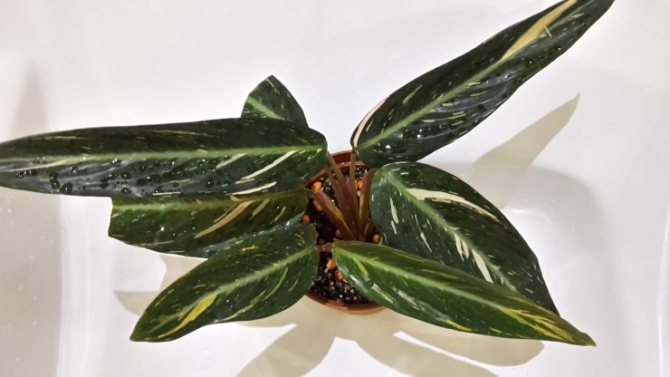

Planting and transplanting
Stromanta prefers to grow in very light, nutritious and loose soils. The soil should be slightly acidic. In alkaline and calcareous soils, it will not develop well enough. In the store, choose soil for arrowroot, azalea, or palm trees. And to make the perfect mixture with your own hands, you need the following ingredients:
- 2 pieces of leafy land;
- 1 part peat;
- 1 part coarse sand;
- some charcoal.
A pot for transplanting a stromant must necessarily have good drainage holes.... Choose a new container for planting higher than the previous one, this is due to the fact that the drainage is filled with a layer of at least 3-5 cm. In addition, the stromant has long roots. But do not overdo it with volumes, as the large size of the pot can lead to acidification of the soil and death of the root system. Ideally, a new pot is taken 2-3 cm wider and deeper than the previous one.
Young stromant plants are transplanted annually up to 4 years of age. Adults need this procedure once every 2-3 years. The transplant is carried out in the spring - in April or May by the transshipment method. If you decide not to disturb the plant once again, then the top layer of the earth should be renewed.
Step by step process
- Pour the drainage in a thick layer on the bottom of the pot, and add the earth mixture on top.
- We carefully remove the stromant from the pot, trying not to disturb the root system. We lightly shake off the old earth, without disturbing the entire earthen lump.
- We lower the plant into the prepared pot and add new soil mixture. We do not tamp it, otherwise the damaged roots will begin to rot and the plant may die.
- After transplanting, if the root system is intact, we water the stromant and add a new volume of settled earth. Pour water from the pallet.
Stromanta is very painfully going through the transplant and comes to life for a very long time after the procedure. If you notice that the plant does not look very good after transplanting, put it in a large transparent bag and tie it up, creating the conditions for a mini-label.
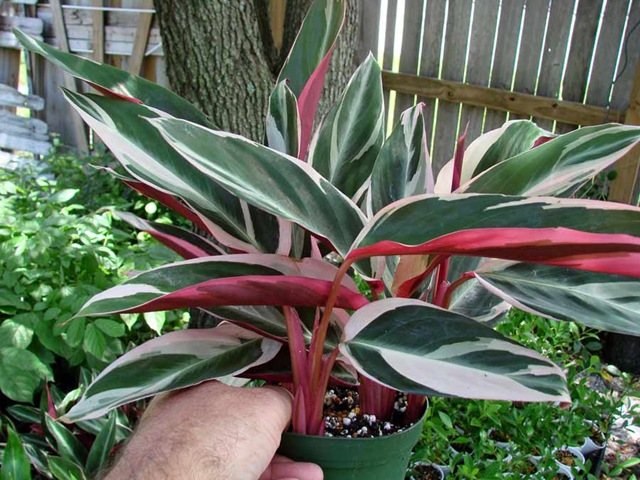

An adult stromant is transplanted once every 2 to 3 years.
During transplanting, all old and dried leaves are removed.
Photo
You can visually familiarize yourself with the Stromant plant in the photo below:
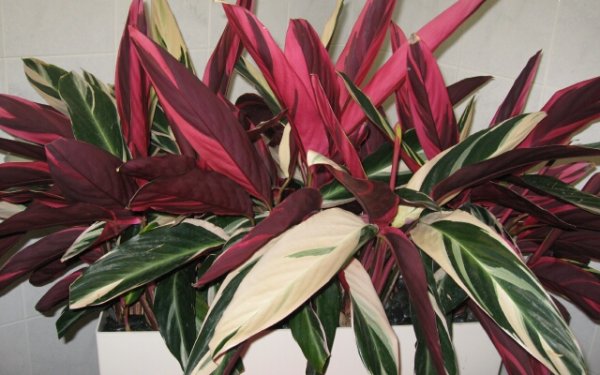

Care
The flower is very demanding to care for, so it is necessary to carry out all procedures correctly and on time.
Watering and spraying
The frequency of watering stromant is influenced by many factors - room temperature, lighting, total air humidity. Therefore, this process must be constantly monitored. The soil in the pot must not be overdried and waterlogged. The top layer of the soil should serve as a guideline - as soon as it dries up, water the plant. The water drained into the sump must be drained.
Summer watering is generous and almost daily. In autumn and winter, the frequency of soil moisture decreases to 2 times every 15 days.
Watering is carried out only with water at room temperature, previously filtered or settled. Cold water will stress the stromant and lead to illness.
As already mentioned, stromanta is very fond of high humidity environments. In the heat of summer and during the heating season, this procedure is carried out daily, perhaps 2-3 times a day, you need to focus on the temperature and total humidity. Only filtered and warm water is used for spraying.


Stromanta likes abundant watering and high humidity.
Top dressing
The period during which stromant is fed is short - from May to August. To nourish the plant, fertilizers are used for ornamental deciduous plants; special feeding for arrowroot will be a very good option. The fertilizer concentration should be made half as much as indicated in the instructions. An excess of minerals in the earth, especially calcium, can be very harmful to the stromant.
Fertilizers are applied once every 2 weeks. They are brought in only after watering.
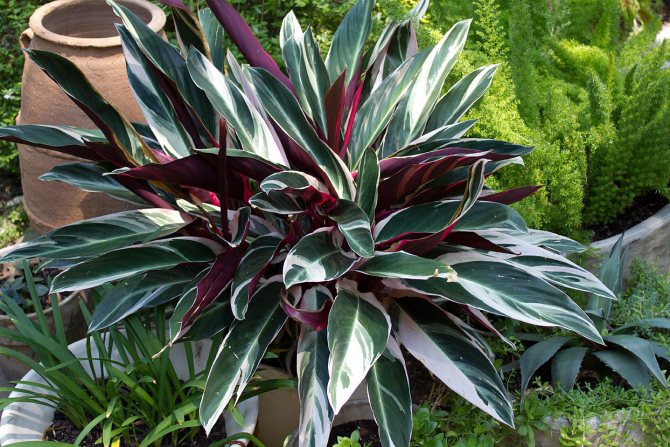

Properly fertilized stromant will delight you with lush foliage
Features of stromantha care depending on the season - table
| Season | Temperature | Lighting and location | Humidity |
| Spring | During the spring-summer period, the flower feels most comfortable at temperatures from 22 ° C to 25 ° C. The plant is not particularly afraid of heat, therefore, an increase in ambient temperature to 30 ° C will not become critical. | Stromanta is a shade-tolerant plant, but does not like shade. As well as direct sunlight. At the same time, it is necessary to keep the stromant in bright diffused light, especially this applies to variegated varieties. The ideal location is west or east facing windows. South-facing windows will do, but they will need to be shaded. | The rainforest dweller prefers 90% humidity combined with warmth throughout the year. This indicator can only be achieved when grown in mini-greenhouses or flower showcases. Room conditions allow maintaining humidity at 70%. Therefore, additional measures are required to increase air humidity. A good solution would be a humidifier, a pallet with wet filler in the form of expanded clay, pebbles or wet moss wrapped around the pot. And, of course, daily spraying of the leaves. Also, the stromanta loves to take a warm shower and responds well to wiping the leaves with a damp cloth. |
| Summer | |||
| Fall | In winter conditions, the optimum temperature is from 18 ° C to 20 ° C. A drop in temperature can become detrimental to the stromant due to freezing of the root system. The potted soil must be kept in a consistently comfortable, warm state. The plant does not tolerate sudden temperature fluctuations. | In winter, the stromant, especially with a bright color, needs to be illuminated with a fluorescent lamp. If the plant is grown under artificial light, then its backlight should illuminate the flower for at least 16 hours a day. | |
| Winter |
Stromanta is very capricious in choosing a permanent place. There should be no heaters and air conditioners nearby. It is impossible for the leaves of the plant to touch the window panes, especially in winter cold and hot weather. Stromanta categorically does not tolerate drafts. Ventilation should be very careful. The plant should not be placed near a window that is constantly open for ventilation. Even in the warm season, it is not recommended to take the stromant out into the open air.
Table: care errors - what to do if leaves curl or tips dry?
| Error | Cause | Elimination |
| The tips of the leaves dry out in stromant, it slows down its growth |
|
|
| The leaves of the stromant first turn yellow and then dry up | The plant has suffered from excessive direct sunlight. |
|
| Leaves begin to curl and become stained | There is not enough moisture in the soil. |
|
| The edges of the leaves turn yellow-brown | Lack or excess of fertilizer. | Monitor application rates and frequency of fertilizing. |
| The stems dry up and the leaves fall |
|
|
| Leaves lose their characteristic color, become faded | Not enough light. | Find a location for the plant with bright, but diffused light. |
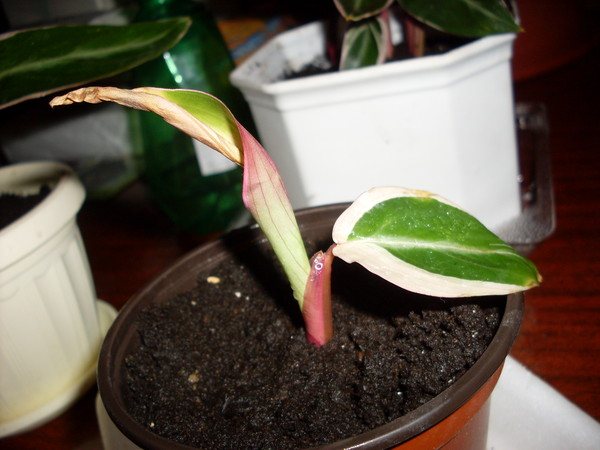

Care mistakes lead to sad consequences.
Temperature regime
The optimal temperature regime for the growth of Stromant is 20-30 degrees. in summer and 18-20 hail. in winter. At 18 deg. and below, the roots will be supercooled, and the flower will die.
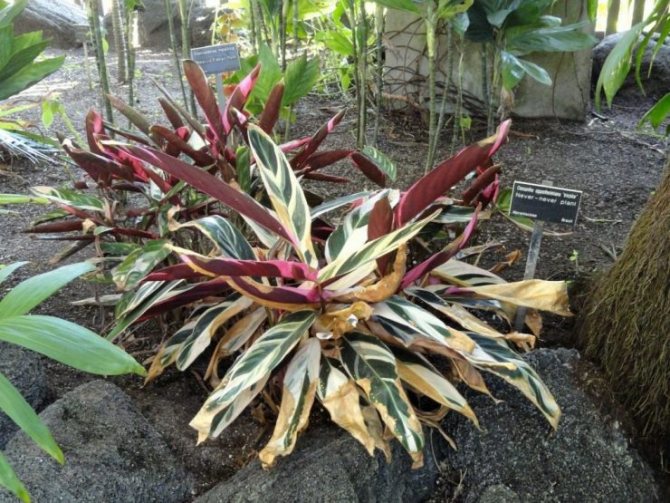

Avoid drafts and sudden temperature changes, especially during the winter months.
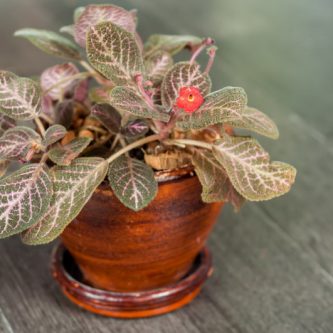

How to grow and care for an episode at home (50 photos)

All about ficuses: 30+ varieties with detailed descriptions and photos
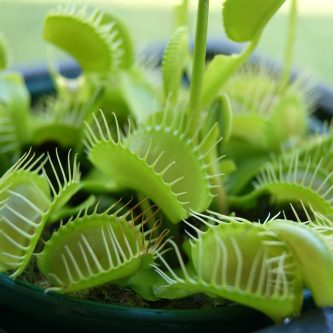

Venus flytrap - benefits in the economy, features of reproduction and home care (50 photos)
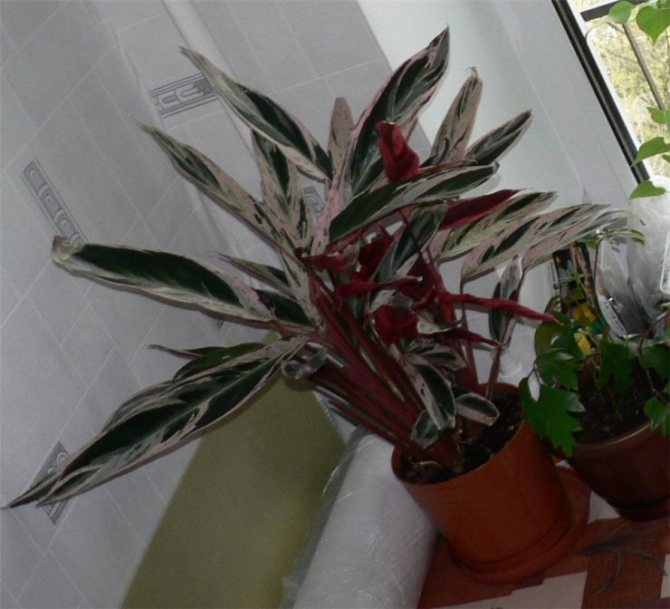

Diseases and pests, their manifestation, treatment and prevention - table
Despite its capricious nature, stromant is very resistant to pests and diseases. But this ability is possessed only by strong and healthy plants, the care of which is carried out according to all the rules.
| Diseases and pests | Symptoms | Control measures | Prophylaxis |
| Root rot | Stems and leaves become lethargic. The roots are affected by rot, this can destroy the plant. |
| Rot of the root system develops when a combination of excessive soil moisture and low temperature in the room. Monitor your watering frequency. Maintain the temperature in accordance with the stromant content norm. |
| Shield | A cluster of brown tubercles appears on the leaves and in the axils of the petioles. Pests feed on cell sap, causing the leaves to discolor, dry out and fall off. | Spray plants affected by pests with Actellik solution (1-2 ml of the drug per 1 liter of water). Can be replaced with other fungicides: Fitoverm, Fufan. Personal protective equipment must be used when using the fungicide. |
|
| Spider mite | Light spots appear on the leaves. Soon the leaf withers and falls off. The most noticeable sign of the appearance of a pest is a thin cobweb on the back of the leaf. |
| |
| Mealybug | The pest feeds on the sap of young shoots and leaves, covering the plants with secretions in the form of off-white lumps. Damaged leaves dry out and fall off. |
What are the signs to recognize diseases and pests - photo gallery
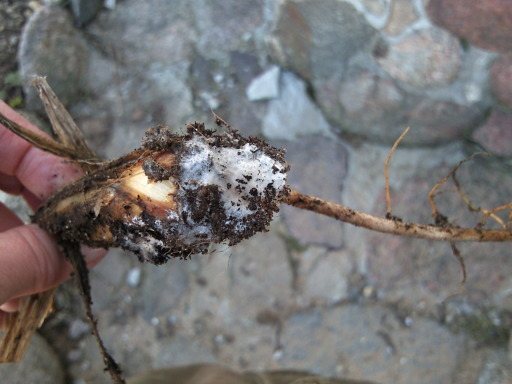

A plant that has died from root rot
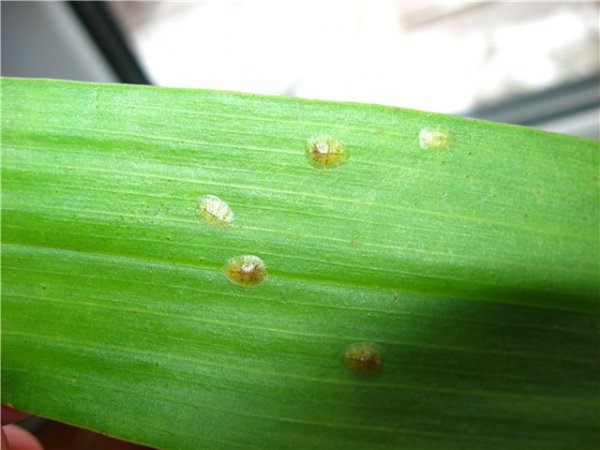

Scabbard on a plant leaf
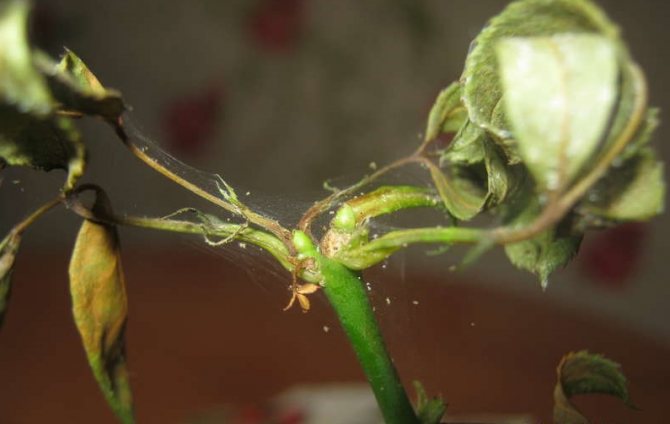

A plant affected by spider mites
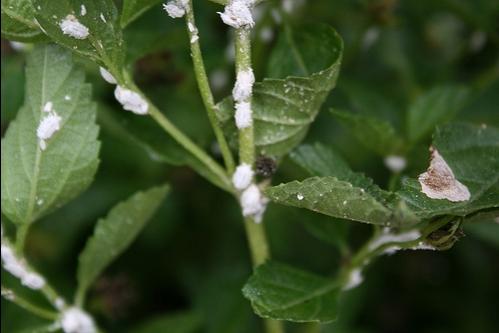

Mealybugs can be identified by off-white lumps
Room humidity
Stromanta loves humidity up to 90%. Spray it regularly 1-2 times a day so that the climate is not dry. The water should be soft.
Put damp moss, small pebbles or expanded clay pebbles in the pallet, but so that the pot is not in the liquid.
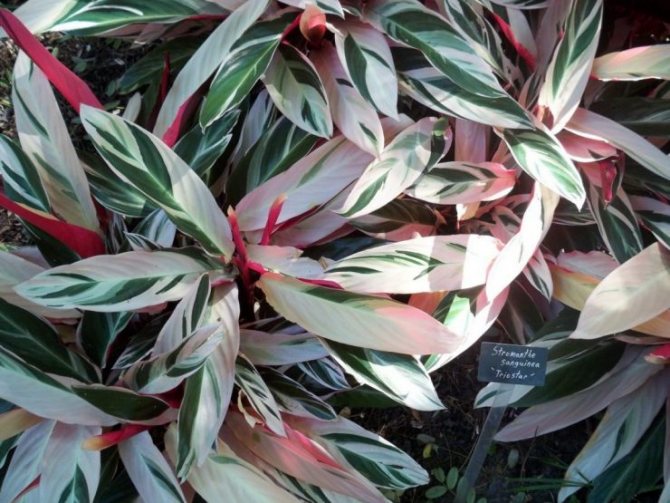

To increase the humidity, you can create greenhouse conditions for the flower by wrapping it in a plastic bag overnight.


Reproduction of stromant
At home, stromant propagates vegetatively: by dividing the bush and apical cuttings.
Division of an adult bush
Usually this method is used in the spring, at the same time as the transplant. Dividing a bush is the easiest and fastest way to reproduce stromant. The procedure is carried out as follows:
- Carefully remove the large specimen from the container.
- Shake off excess soil. Use your hands to separate 2-3 young shoots from the mother plant. Perform actions carefully, untwisting the roots with your hands and trying not to damage them.
- Plant the detached plants in small pots filled with moistened peat substrate. Don't forget about drainage!
- Cover the pots with a transparent plastic bag to create a greenhouse environment.Place in a warm, shaded place.
- Water only with warm water, not earlier than the top layer of the earth dries up.
- After about a month, the plant will fully root and release young leaves.
- Transplant the rooted stromanthus into a suitable potting soil and care for it as if it were an adult plant.
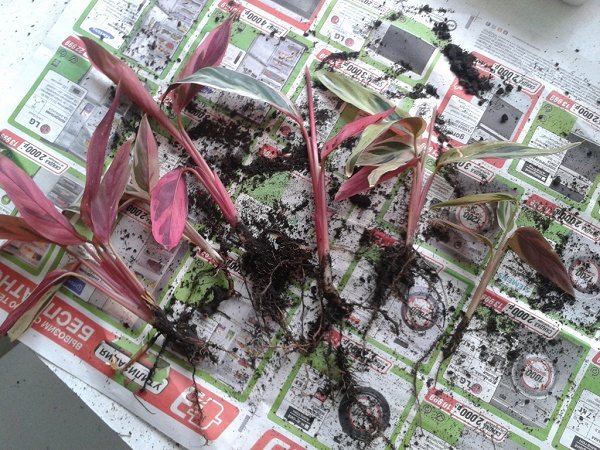

The division of the stromant bush occurs simultaneously with the transplant
Rooting of apical shoots
Apical shoots take root in late spring to mid-summer. This method is somewhat more complicated than the previous one. Rooting of cuttings is as follows:
- In a healthy adult stromant, cut off cuttings from 8 to 10 cm in height. Be sure to have 2-3 leaves. Make a cut slightly below the point where the leaf is attached to the stem.
- Dip the separated cuttings into water and cover with a bag, creating the conditions of a mini-greenhouse.
- Change the water weekly. Stimulants for root formation can be added to it.
- Roots grow after 5-6 weeks. Plant the cuttings in a peat substrate, creating greenhouse conditions.
- After the young leaves appear, transplant the plants into pots with a medium suitable for adult stromant.
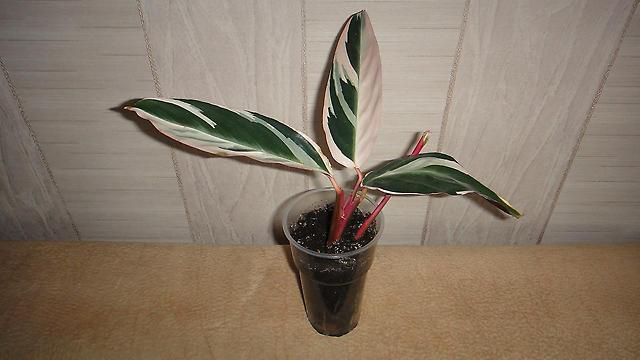

Rooted apical shoot of stromant
Stromanthus can be propagated using seeds. But they have a rather low germination rate, and the process itself is time-consuming and costly. Therefore, the seed propagation method is more practiced when grown on an industrial scale.
Soil features
The plant feels great in slightly acidic, loose and nutritious soil, which includes sand, peat and decayed leaves with an admixture of crushed charcoal.


Do not forget about the expanded clay drainage, which fills the pot by 1⁄4.


Botanical description
The plant has a very bright, festive look, thanks to its colorful, variegated and unusual leaves on elongated petioles. The upper is painted in dark green with stripes of cream, pink and white. The other side and petioles are purple, violet, burgundy and crimson. These incredibly colorful leaves are always drawn towards the light source.
Due to the fact that at night the leaves rise and touch each other, “getting ready for sleep,” it makes a soft noise. Because of this property, the stromante was given another name "God-face" or "Praying Flower".
In nature, in summer, the plant throws out a long peduncle with white and yellow flowers, red bracts are attached to them. In indoor conditions, the plant blooms extremely rarely.
The significance of a flower according to Feng Shui
According to the popular East Asian practice of Feng Shui, stromanta has a direct connection with the Sun and Mars, which charge them with hot energy. Starting from this, the plant is able to warm a person, thereby protecting against hypothermia and helping to recover faster in case of a cold. It has no less benefit on the cardiovascular system: it prevents the formation of blood clots in blood vessels, normalizes cardiac activity.
According to Feng Shui, the stromant should be located in the South-East or East corners. Then the plant will emit positive energy flows aimed at financial stabilization and improving the health of people living in the apartment.
Beneficial features
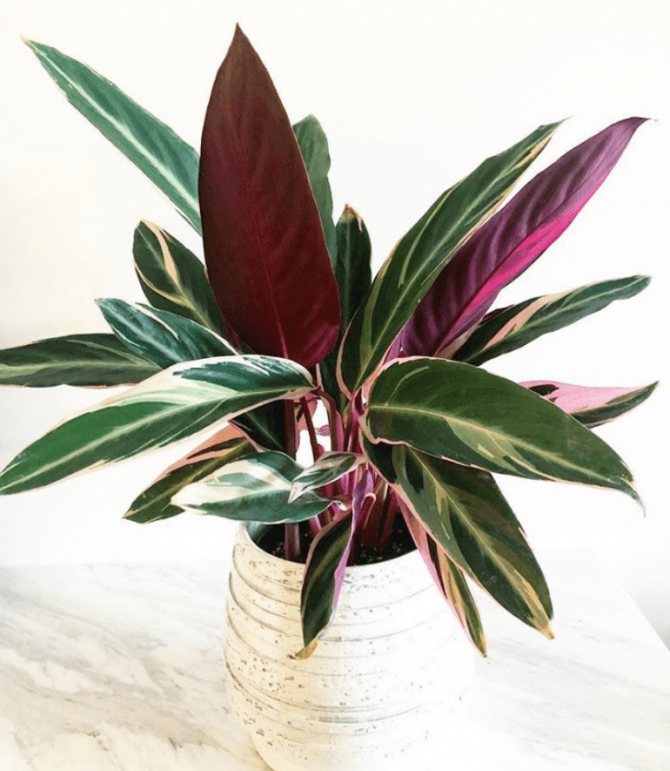

Photo of stromant in a pot
The plant is necessary for those who suffer from insomnia. It soothes the nervous system before bed, relieves stress and fatigue. There is also an opinion that stromanta helps to gain self-confidence, instills optimism, cheers up and gives additional vitality.
Table: recommendations for caring for the stromant depending on the season
Taking care of a naughty plant like stromanthus can be quite challenging. The season has a direct impact on the rules for keeping this plant.
| Season | Watering | Temperature | Top dressing | Pruning |
| Spring | It is necessary to water abundantly while maintaining a high level of soil moisture. | + 22-27 ºС | Twice a month | Removing dead old leaves |
| Summer | Not required | |||
| Fall | Moderate watering is required. | + 18–20 ºС | ||
| Winter | Not required |
Temperature
The heat-loving stromant develops best in summer at a temperature of 22-28 ° C. She does not tolerate extreme heat well.
Decrease and changes in temperature in the summer have a bad effect on the decorativeness of the stromant.
In winter, the keeping temperature of the flower should also be high. Reducing it even to 17 ° C is unacceptable. The flower reacts painfully to hypothermia of the root system.
A stable temperature all year round is the most comfortable conditions for this plant. Stromanta grows well in winter in a heated room, it does not need a cold winter.
In winter, it is necessary to remove the plant from heating radiators, since overheating and a decrease in humidity are very harmful to the plant. The flower does not tolerate cold drafts, so you need to find a quiet corner for it with minimal air movement.
How to deal with pests?
Despite the capriciousness, stromant is relatively rarely affected by pests. But it is impossible to neglect prevention - the flower "departs" from any damage for a long time and painfully.
Common pests stromant - table
| Pest | Typical symptoms | How to deal with the problem? |
| Spider mite | The tips of the leaves dry, they themselves curl, the color fades. The petioles at the junction with the leaf are entangled in thin, almost transparent threads. If you do not take action, the plant will hide under a continuous layer of whitish mass. | Good prevention is regular spraying and ultraviolet light. At least once a week for 2-3 minutes, irradiate the leaves on both sides with a quartz lamp. Having found a pest, apply a soap-alcohol solution to the leaves for 30-40 minutes, then take a shower. After 2-3 hours, spray the flower with acaricide (Fitoverm, Agravertin, Aktofit, Vermitek, Nisoran, Sunmayt, Oberon) and, if possible, tightly secure a plastic bag on top. They take it off after 2-3 days. You will need at least 3 treatments with different drugs with an interval of 10–20 days. A folk remedy is an infusion of garlic or a decoction of cyclamen tubers. |
| Shield | At the bottom of the leaves appear at first almost flat, then more and more convex rounded outgrowths of gray-brown color. Areas around them turn yellow, then discolor. | Visible pests are removed with a cotton pad dipped in alcohol or alcohol tincture of calendula. Then they arrange a hot (+ 45… + 50 ºС) shower for the flower. The stromant and the soil are well sprayed with an insecticide (Bankol, Aktellik, Mospilan, Metaphos) and closed in a bag for two days. In especially severe cases, Phosbecid is used, but it is very toxic. After processing 2-3 days, protect the flower from the bright sun. |
| Whitefly | The larvae suck the juice from the leaves. They deform and dry out. The flower almost stops growing. | Adults are successfully scared off by infusions of strong-smelling herbs, onions, and garlic. Sticky tape is effective for catching flies. Of insecticides, Aktar, Admiral, Commander, Tanrek, Inta-Vir are used. The solution is either sprayed on the flower and soil every 5-7 days for 1.5-2 months, or the substrate is watered at regular intervals for 3-4 weeks. In the second case, the concentration of the agent is halved. |
| Thrips | Insects in whole colonies settle on the underside of the leaf plate, sucking out the juice. At the same time, an almost transparent sticky discharge appears. From above, the leaf is covered with thin beige "strokes" and takes on a silvery hue. | Adult thrips are fought in the same way as whiteflies. A folk remedy against larvae is an infusion of potato tops, tobacco crumbs or mustard leaves. Effective insecticides - Mospilan, Apache, Dantop, Gaupsin, BI-58. The flower is washed under the shower, sprayed, placed in a bag for 2-3 days. |
Harmful insects in the photo
Spider mites are fought with the help of special preparations - acaricides (the hotter it is outside, the more often the treatment needs to be carried out)
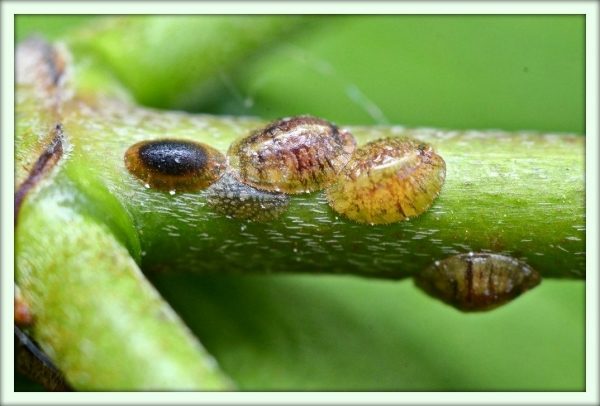

The shield is protected by a rather durable shell, so folk remedies and even some insecticides do not have a noticeable effect on it


For some reason, the whitefly loves yellow very much - homemade traps made from pieces of yellow cardboard smeared with long-drying glue are quite effective against the pest
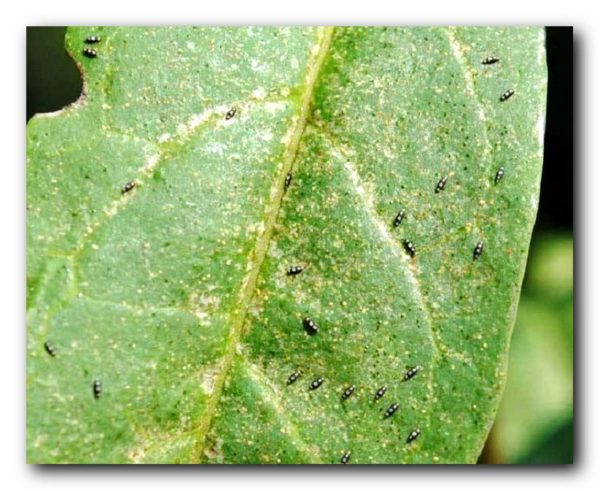

Thrips are easily identified by the uncharacteristic silvery hue that the leaf plate acquires.
Lighting
The flower grows well in bright but diffused light, like in a tropical forest under the cover of tall trees.
Summer rays of the sun can become destructive for him, so it is recommended to shade the flower.
In winter in temperate climates, the flower suffers from a lack of light. He needs bright lighting; the winter sun, falling on the leaves, does not lead to their burns.
Stromanta is very demanding on lighting... With a lack of light, its leaves turn pale, and the plant also reacts to an excess of light.
Problems
This very demanding and capricious plant often gives its owner a lot of trouble. There are a lot of problems with growing stromant. Here is some of them.
- If the plant leaves drythis is most likely due to burns from direct sunlight. It is necessary to place the plant so that the rays of the sun do not fall on it and do not burn the leaves;
- If the leaves turn pale - the reason for this can be both an excess of lighting, and its lack;
- If the plant slows down, and the leaves dry and turn brown - this is a sign of spider mite infestation. In this case, treatment with pesticides is necessary. But this is how the plant can react to very dry air. Therefore, if no pests are found, you need to humidify the air;
- Plant leaves fall not only with too dry air, but also from acidification of the soil with improper watering. If you follow the watering schedule, this will not happen;
- Yellowing of the tips of the leaves signals an excess or lack of food. Therefore, you need to feed the plant very carefully.


